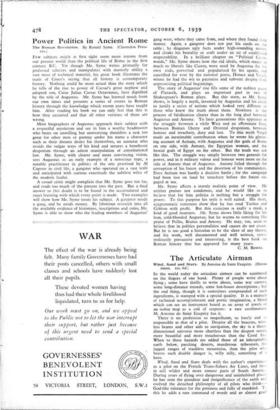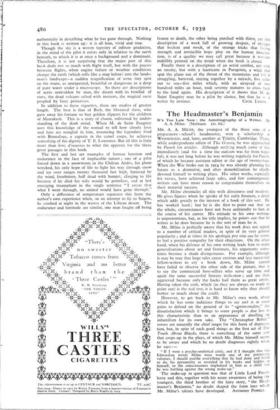The Articulate Airman
IN the world today the articulate airmen can be numbered on the fingers of one hand. Plenty of people write about flying ; some have thrills to write about, some war careers, some long-distance records, some hot-house descriptions ; but the real thing, though it is sometimes compounded of such ingredients, is stamped with a special quality. It is a mixture of technical accomplishment and poetic imagination, a blend which can see an instrument board as an array of jewels or an isobar map as a coil of serpents : a rare combination. M. Antoine de Saint Exupery has it.
There is no profession so magnificent, so lonely and responsible as that of a pilot. Despite all the beacons, wire- less beams and other aids to navigation, the sky is a three- dimensional universe more chartless than the deepest ocean, more beautiful and more treacherous than the Coral Se- When to these hazards are added those of an inhospitab. earth below, parching deserts, murderous tribesmen, jagged ranges of trackless mountains, then the pilot wli braves such double danger is, willy nilly, something of hero.
Wind, Sand and Stars deals with the author's experience as a pilot on the French Trans-Sahara Air Lines, and lat, in still wilder and more remote parts of South Americ During years of flying over dangerous and 'uninhabited &co he has seen the grandeur and insignificance of the earth and evolved the detached philosophy of all pilots who think--- God like tolerance for the pettiness and folly of mankind. T this he adds a rare command of words and an almost grui:
authenticity in describing what he has gone through. Nothing in this book is written up: it is all lean, vivid and true.
Though the sky is a woven tapestry of infinite gradation, in the mind of the pilot it exists only in relation to the earth beneath, to which it is at once a background and a dominant. Therefore, it is not surprising that the major part of this book deals not so much with flight itself, but with the pauses between flights, when engine failure or weather conditions change the earth (which rolls like a map below) into the lands- man's landscape—a sudden magnification of some tiny spot on the route, as unexpected, beautiful or dangerous as a drop of pure water under a microscope. So there are descriptions of acres untrodden by man, the desert with its bowlful of stars, the dead volcano salted with meteors, the magical oasis peopled by fairy princesses.
In addition to these vignettes, there are studies of greater length. The best is that of Bark, the liberated slave, who gave away his fortune to buy golden slippers for the children of Marrakesh. This is a story of charm, enlivened by under- standing of the Arab mind. When M. de Saint Exupery uses this knowledge of the nomad to tell how closely love and hate are mingled in him, instancing the legendary feud with Bonnafous, a captain in the camel corps, he achieves something of the dignity of T. E. Lawrence. But all this is little more than hors d'oeuvres to whet the appetite for the three great passages in this book.
The first and last are examples of human heroism and endurance in the face of implacable nature ; one of a pilot forced down in a snowstorm in the Chilean Andes, his plane wrecked, his only hope of life to fight his way through snow and ice over ranges twenty thousand feet high, battered by the wind, frostbitten, half dead with hunger, clinging to life because if he died his wife would be penniless, and at last emerging triumphant in the single sentence " I swear that what I went through, no animal would have gone through."
Only a difference of temperature separates this from the author's own experience when, on an attempt to fiy to Saigon, he crashed at night in the wastes of the Libyan desert. The endurance and fortitude are similar, one man fought off being frozen to death, the other being parched with thirst, yet this description of a week full of growing despair, of mirages that beckon and mock, of the strange tricks that failing strength and invincible hope play on the human imagina- tion, is of a quality we may call great because it remains indelibly printed on the mind when the book is closed.
Finally there is a description of an aerial combat, not with an enemy, but with a hurricane in Patagonia, a wind that spat the plane out of the throat of the mountains and left it struggling, battered, staying together by a miracle, five miles out to sea—five miles which, with an airspeed of two hundred miles an hour, took seventy minutes to cross back to the land again. His description of it shows that M. de Saint Exupery may be a pilot by choice, but that he is



































 Previous page
Previous page